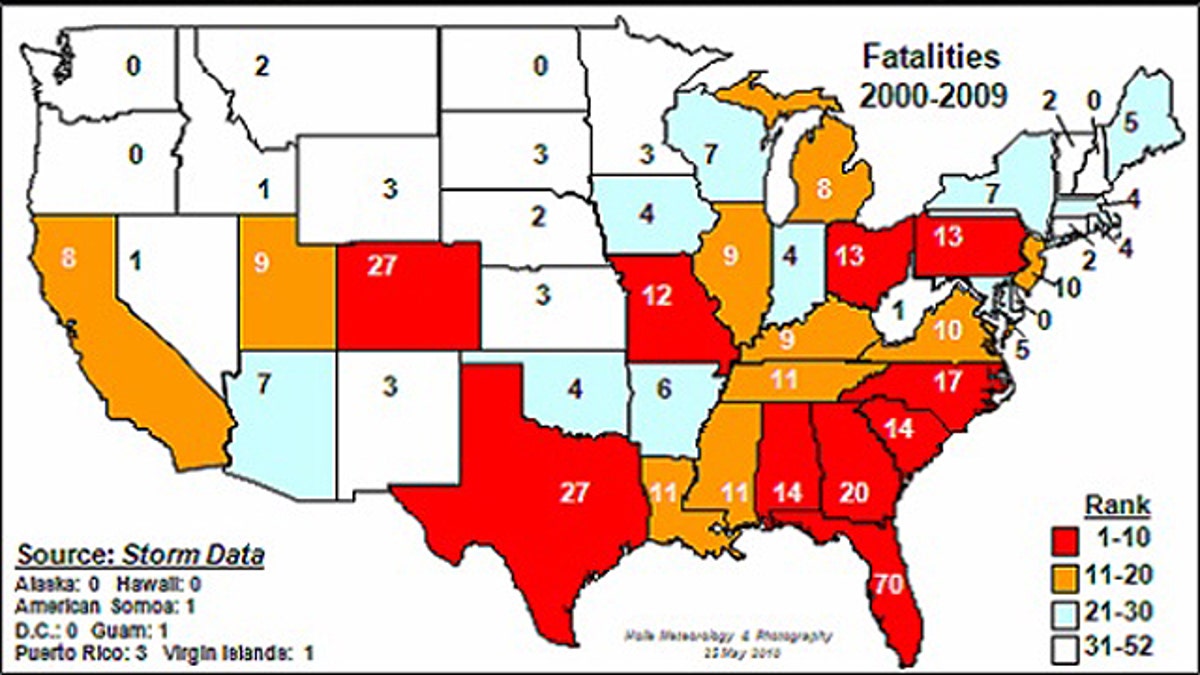
When lightning strokes, the results can be fatal. This map displays the number of lightning-related deaths by state from 2000-2009. (Vaisala Inc.)
Lightning is one of Mother Nature's double-edged swords; it is beautiful to watch as it lights up the sky, but it is dangerous when it hits the ground at a scorching 50,000 degrees F and brings with it a jolt of 100 million electric volts.
Lightning comes in various types, but the most hazardous strikes are from cloud-to-ground lightning, according to the National Oceanic and Atmospheric Administration. The U.S. National Lightning Detection Network, owned and operated by Vaisala Inc. and based in Helsinki, Finland, monitors cloud-to-ground lightning activity across the U.S. Vaisala has just released their latest data on lightning strikes from 1996-2008 and lightning deaths from 1999-2008.
There are states that seem to attract lightning such as Florida, which averages the most flashes per year with 1.4 million and states that seem to repel lightning like Rhode Island, which averages just over 2,000 flashes in a year.
Comparing the lightning strike data to lightning fatality data, it would make sense that states with the highest number of lightning strikes would also be the states with the highest number of lightning deaths.
"No, it doesn’t work that way," said Ron Holle, a meteorologist for Vaisala. "For example, Florida had the highest number of lightning fatalities, with 70, and was also ranked number one with the highest number of measured cloud-to-ground flashes, but the state with the second highest number of deaths from lightning strikes is Colorado, with 28, but it ranks much lower on the list of lightning strikes at 31 with just over 500,000 flashes per year."
While none of the 50 states or the District of Columbia have been free from lightning strikes, over the last nine years Alaska, Delaware, Hawaii, New Hampshire, North Dakota, Oregon and the District of Columbia have not had a single death caused by lightning.
So which state has the least lightning and the least deaths?
"Oregon, any town along the Oregon coastline," said Martin A. Uman, an electrical engineer at the University of Florida in Gainesville, and co-director of the Lightning Research Group and the International Center for Lightning Research and Testing.
Even in the states with no lightning deaths, the fact that every state has lightning strikes puts the public at risk. This week, June 20-26, is National Lightning Safety Awareness Week sponsored by NOAA. According to NOAA, five people have died from U.S. lightning strikes so far this year.
"Lightning safety is an individual responsibility and you are the only one who can keep yourself from being injured," said Mary Ann Cooper, a retired professor in the Department of Emergency Medicine and Bioengineering at the University of Illinois at Chicago, who is also an expert in how lightning affects the body. "The vast majority of the people who were killed [by lightning strikes] last year were within fifty feet of a safe location such as their own home, but chose to stay outside a little longer."
Her advice? "Almost all lightning injuries can be avoided by following 'when thunder roars, go indoors,'" said Cooper.




















